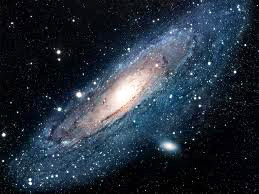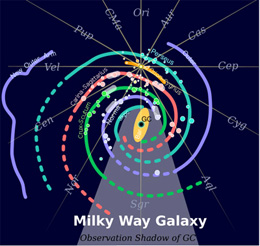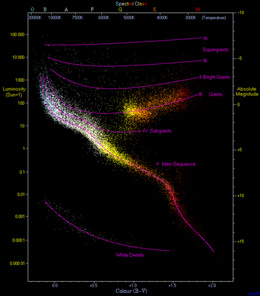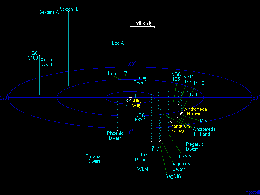How big is the Milky Way Galaxy?
Reading and Assessment
When you look up at the night sky at night, every star you see is part of the Milky Way galaxy. On a clear night you can see a narrow band of stars stretching across the sky. Through a telescope or pair of binoculars it becomes clear that this band is a dense region of the Milky Way. The band of light we see as the Milky Way is the light that originates from stars and other material that lie within the galactic plane (Note: the galactic plane is the actual mid-plane – the flat part – of our galaxy’s huge spinning disk of stars). The disk of the Milky Way galaxy spans a distance of about 100,000 light years (one light year is about 9.5 x 1015 meters). The Milky Way galaxy though is only about 2000 light years thick at the edge of a spiral arm where the sun is located.
Our Galaxy contains about 200 billion stars. Most of the stars are located in the disk of our galaxy, which is the site of most of the star formation because it contains lots of gas and dust.
 |
The Andromeda galaxy is a spiral galaxy much like our own Milky Way galaxy but is approximately 2.5 million light-years away. The Milky Way and the Andromeda Galaxy are a binary system of giant spiral galaxies belonging to a group of 50 closely bound galaxies known as the Local Group. Andromeda
is one of the few blue-shifted galaxies (moving toward us)
at a speed of 100 to 140 kilometers per second and is expected
to collide in about 4.5 billion years with our own Milky
Way galaxy.
|
||
Photo:
NASA |
On a clear night you can see about 3,000 stars. This is only a fraction of the stars in the Milky Way galaxy -- there are approximately 200-400 billion stars in the Milky Way galaxy.
 |
Our sun and solar system is at the edge of a spiral arm called the Orion Arm, and is about two-thirds of the way from the center of our galaxy to the edge of the starlight. See image to left -- sun is in the cross-hairs
Image from Wikipedia |
Just as the earth orbits around the sun, our solar system orbits the galaxy's center of mass -- but each rotation takes 225 million Earth years. This period of time is called a "cosmic year".
What are the parts of the Milky Way galaxy?
A spiral galaxy like the Milky Way has 3 basic components to its visible matter: (1) the disk (containing the spiral arms), (2) the halo, which extends beyond the disk, and (3) the nucleus or central bulge. The halo of the galaxy is rather spherical in shape and contains little gas, dust, or star formation. The clusters found in the halo are globular clusters, so the halo contains very old stars. (See reference for more information).
What is in the center of the Milky Way galaxy?
The center of the Milky Way galaxy lies in the direction of the constellation Sagittarius, and it is here that the Milky Way looks brightest. From Sagittarius, the Milky Way appears to pass westward through the constellations of Scorpius, Ara, Norma, Triangulum Australe, Circinus, Centaurus, Musca, Crux, Carina, Vela, Puppis, Canis Major, Monoceros, Orion and Gemini, Taurus, Auriga, Perseus, Andromeda, Cassiopeia, Cepheus and Lacerta, Cygnus, Vulpecula, Sagitta, Aquila, Ophiuchus, Scutum, and back to Sagittarius. The fact that the Milky Way divides the night sky into two roughly equal hemispheres indicates that the Solar System lies close to the galactic plane. (See Reference from Wikipedia)
The center of the galaxy looks awfully bright from the image above. Perhaps millions of stars are in the center. But, radio telescopes tell us more. Observational data suggests that a massive black hole exists at the center of the central star cluster.
The galactic center harbors a compact object of very large mass as determined by the motion of material around the center. The intense radio source named Sagittarius A*, thought to mark the center of the Milky Way, is newly confirmed to be a supermassive black hole.[See reference below] Most galaxies are believed to have a supermassive black hole at their center.
How old is the Milky Way galaxy?
Astronomers have known that the Milky Way is among the oldest of galaxies. A recent study puts the age of the Milky Way at approximately 14.5 billion years, plus or minus more than 2 billion years. (See reference below)
 |
You can see an example of a Hertzsprung-Russell diagram to the right. This diagram is based on measurements from 23,000 stars in our Milky Way galaxy. The Hertzsprung-Russell diagram is named after its creators, astronomers Ejnar Hertzsprung and Henry Norris Russell. These collections of stars by brightness and temperature are important when talking about stellar evolution. In general, stars are created in the main sequence. (Of course, when we say "in the main sequence" we really mean "having a brightness and a temperature that causes them to be plotted within the main sequence on a Hertzsprung-Russell diagram.") After billions of years, they expand into red giants. Then, after another one or two billion years, they shrink into white dwarfs. See: Wikipedia -- Hertzsprung-Russell Diagram |
|
What's beyond the Milky Way galaxy?
 |
The Milky Way galaxy is just one of probably several hundred billion galaxies in the observable universe. The image on the left shows the part of the universe that is within 5 million light years of earth. The Milky Way is shown as one of three large galaxies that belong to the Local Group (Milky Way galaxy, Andromeda galaxy and Triangulum galaxy). A visit to the site atlasoftheuniverse will let you zoom in and out and give you a better feel for where earth lies in the universe. |
|
Further Readings
When Galaxies Collide - In 4 billion years the Milky Way and Andromeda Galaxy will pass through each other.
Wikipedia -- Milky Way galaxy
Milky Way galaxy lecture from University of Oregon -- excellent read for more advanced students. This lecture page also has a quiz attached at the end of the text.
(4 September 2008). "Astrophysics: Bringing black holes into focus". Nature 455 (7209:39–40.)
Scientist refines cosmic clock to determine age of Milky Way --University of Chicago
Where is M13? — A Three Dimensional Galactic Atlas -- This requires a download
An Atlas of the Universe -- This web page is designed to give everyone an idea of what our universe actually looks like -- It's a great piece of work!
Solar System
- Table of Contents
- Introduction
- About the Solar System
- The Sun
- Mercury
- Venus
- Earth
- Moon
- Mars
- Asteroid belt
- Jupiter
- Saturn
- Uranus
- Neptune
- Pluto
- Comets
- Kuiper Belt
- Oort Cloud
- How the Solar System was born
- What will happen to the Solar System in the future
- Solar System/Space exploration
- Glossary
Beyond The Solar System
Earth Systems
- Layers of the Earth -- What are the different types of Seismic Waves
- What causes precipitation? What causes it to rain or snow? What causes dew on the ground?
- What is the Coriolis Effect?
- About gravity, mass, and weight
- What are seismic waves? What are the different types of seismic waves?
- What is Humidity? How is Humidity Measured?
- What causes precipitation --( rain or snow)?
HTML5 Simulations
Scientific Notation and Units and Measurement
All text is available under the terms of the GNU Free Documentation License (see Copyrights for details). Disclaimers. Wikipedia is powered by MediaWiki, an open source wiki engine.